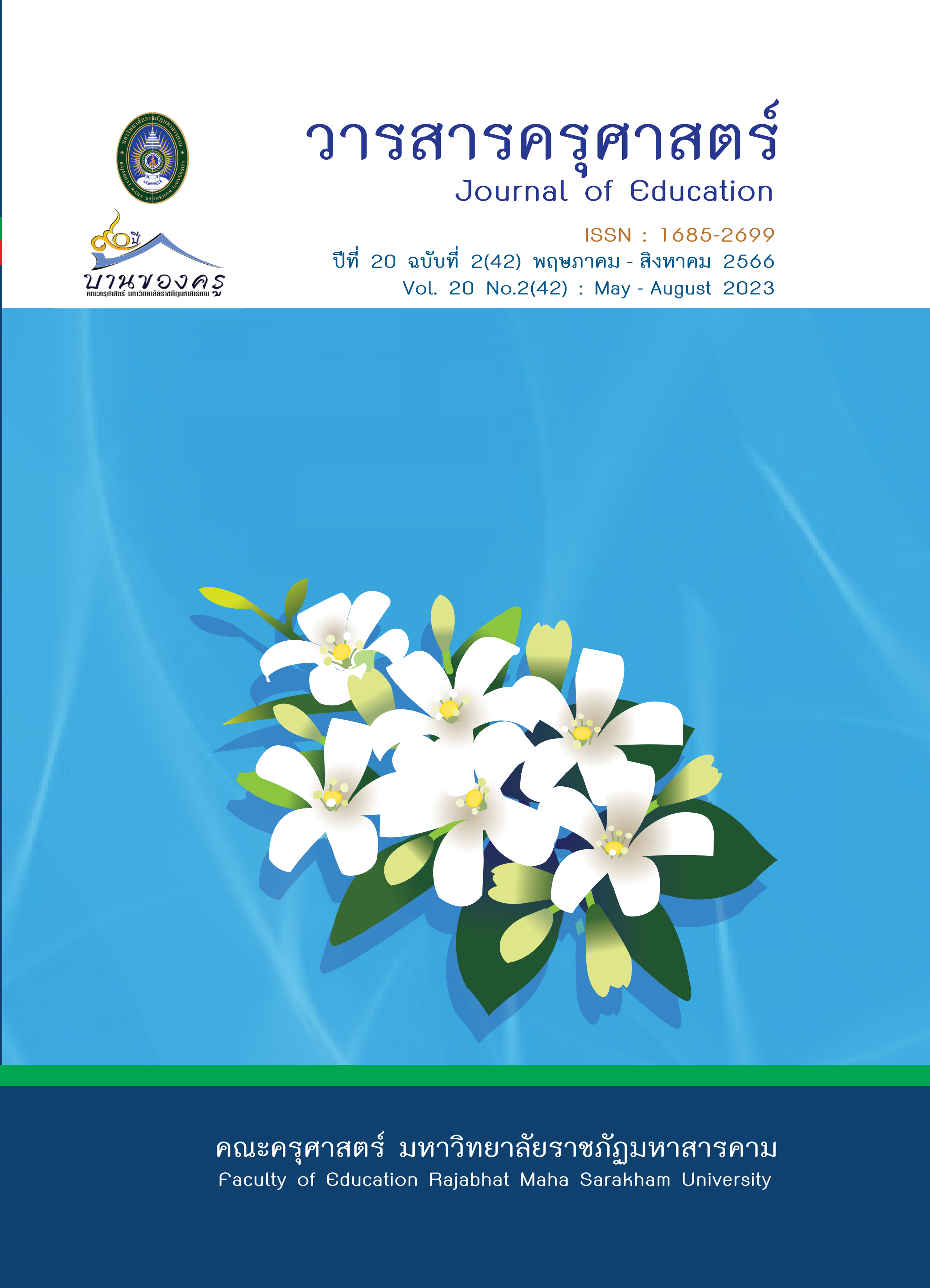A Construction of Measurement on Learning and Innovation Skill for Grade 6 Students
Main Article Content
Abstract
The purposes of this research were 1) to construct of Learning and Innovation Skill test for grade 6 students, 2) to find the quality of the Learning and Innovation test for grade 6 students, and 3) to construct norms of the Learning and Innovation Skills test for Grade 6 students. The sample used in the research were 931 grade 6 students, selected by multi-stage random sampling.
The results of the research were as follows: 1. The Learning and Innovation Skills test consisted of 36 items: 9 items for creativity and innovation, 15 items for critical thinking and problem solving, and 12 items for communication and cooperation. 2. The quality of the learning and innovation skills test for Grade 6 students, there was a content validity by index of congruence (IOC) ranging from 0.60 to 1.00, discriminant power ranging from 0.22 to 0.55, and a reliability for the whole version equal to 0.84. Focusing on the construct validity examined by Confirmation Factor Analysis, it was found that 3 components of the Learning and Innovation Skills test were weighted from the highest to the lowest, i.e., critical thinking and problem solving, communication and cooperation and creativity and innovation, ranking from 0.98, 0.97 and 0.92 respectively. According to the Goodness of Fit Index (GDP) between the model and empirical data were rated at x2=173.95, x2/df=1.09, P-Value=0.20 and RMSEA=0.02, indicating the model is structurally valid. Considering with Norms of the Learning and Innovation Skills test for Grade 6 students, there is grouped to be a normal criterion of normal T scores between T22 to T85.
Article Details

This work is licensed under a Creative Commons Attribution-NonCommercial-NoDerivatives 4.0 International License.
ข้อกำหนดเบื้องต้นที่ผู้นิพนธ์(ผู้ส่งบทความ) ควรทราบ
1. ผู้นิพนธ์ที่ประสงค์จะลงตีพิมพ์บทความกับวารสาร ตั้งแต่เดือนมกราคม 2563 เป็นต้นไป ให้ใช้รูปแบบใหม่ (Template 2563) โดยสามารถดูตัวอย่างได้ที่เมนู GUIDELINES
2. จะตีพิมพ์และเผยแพร่ได้ ต้องผ่านการประเมินจากผู้ทรงคุณวุฒิ (Peer Review)
3. การประเมินบทความโดยผู้ทรงคุณวุฒิ (Peer Review) เป็นแบบ Double Blind
4. การอ้างอิงบทความใช้หลักเกณฑ์ APA (American Psychological Association) คลิก
5. บทความถูกปฏิเสธการตีพิมพ์ ไม่ผ่านการประเมิน ผู้นิพนธ์ขอยกเลิกเองหรือชำระเงินก่อนได้รับการอนุมัติ ทางวารสารไม่มีนโยบายการคืนเงิน
References
กระทรวงศึกษาธิการ. (2551). หลักสูตรแกนกลางการศึกษาขั้นพื้นฐาน พุทธศักราช 2551. โรงพิมพ์องค์การรับส่งสินค้าและพัสดุภัณฑ์.
กัลยา วานิชย์บัญชา. (2549). สถิติสำหรับการวิจัย (พิมพ์ครั้งที่ 2). จุฬาลงกรณ์มหาวิทยาลัย.
ชนัดดา เทียนฤกษ์. (2558). การพัฒนาลักษณะเฉพาะของแบบวัดทักษะชีวิตและอาชีพแห่งศตวรรษที่ 21 ของนิสิตนักศึกษาปริญญาตรี [วิทยานิพนธ์ปริญญามหาบัณฑิต]. จุฬาลงกรณ์มหาวิทยาลัย.
ทรงศักดิ์ ภูสีอ่อน. (2561). การประยุกต์ใช้ SPSS วิเคราะห์ข้อมูลงานวิจัย (พิมพ์ครั้งที่ 8). ตักสิลาการพิมพ์.
ปณิชา ชัยกุลภัทรโชติ. (2563). การพัฒนาแบบวัดทักษะในศตวรรษที่ 21 ด้านการเรียนรู้และนวัตกรรมของนักเรียนชั้นประถมศึกษา [วิทยานิพนธ์ปริญญามหาบัณฑิต]. มหาวิทยาลัยนเรศวร.
ปาริชาติ อังกาบ. (2561). การสร้างแบบวัดทักษะชีวิตและอาชีพ ตามแนวคิดในศตวรรษที่ 21 สำหรับนักเรียนชั้นมัธยมศึกษาตอนปลาย [วิทยานิพนธ์ปริญญามหาบัณฑิต]. มหาวิทยาลัยมหาสารคาม
พรรทิพย์ ทั่วสูงเนิน. (2562). การสร้างแบบวัดทักษะการเรียนรู้และนวัตกรรมในศตวรรษที่ 21 สำหรับนักเรียนชั้นมัธยมศึกษาปีที่ 2 สังกัดสำนักงานเขตพื้นที่การศึกษามัธยมศึกษาเขต 20. วารสารคุรุศึกษา มหาวิทยาลัยราชภัฏอุดรธานี, 1(2), 35-51.
ไพศาล วรคำ. (2554). การวิจัยทางการศึกษา (พิมพ์ครั้งที่ 2). ตักสิลาการพิมพ์.
ล้วน สายยศ และอังคณา สายยศ. (2543). เทคนิคการวัดผลการเรียนรู้ (พิมพ์ครั้งที่ 2). สุวีริยาสาส์น.
วิจารณ์ พานิช. (2555). วิถีการสร้างการเรียนรู้เพื่อศิษย์ในศตวรรษที่ 21. มูลนิธิสดศรีสฤษดิ์วงศ์.
ศิริชัย กาญจนวาสี. (2552). ทฤษฎีการทดสอบแบบดั้งเดิม (พิมพ์ครั้งที่ 2). โรงพิมพ์แห่งจุฬาลงกรณ์มหาวิทยาลัย.
สมนึก ภัททิพยธนี. (2558). การวัดผล (พิมพ์ครั้งที่ 10). ประสานการพิมพ์.
สำเริง บุญเรืองรัตน์ และคณะ. (2554). สติปัญญาและความถนัดทางการเรียนรู้ของมนุษย์ ทฤษฎี วิธีวัดและการพัฒนา. มหาวิทยาลัยวงษ์ชวลิตกุล.
สุภมาส อังศุโชติ . (2552). สถิติการวิเคราะห์สำหรับการวิจัยทางสังคมศาสตร์และพฤติกรรมศาสตร์ : เทคนิคการใช้โปรแกรม Lisrel. เจริญดีมั่นคงการพิมพ์.
Bani-Hamad, A. M. H., & Abdullah, A. H. (2019). Devaloping Female Students’ Learning and Innovation Skill (4cs) In Physics through Problem Based Learning. Internation Journal of Academic Research in Business and Social Sciences, 9(12), 574-586.
Hair, J. F., Black, W. C., Babin, B. J., Anderson, R. E., & Tatham, R. L. (2006). Multivariate Data Analysis (6th). Pearson Education.
Krejcie.R.V, & D.W.Morgan. (1970). Determining Sample Size for Research Activities. Education and Psychological Measurement, 30(3).
Ministry of Education. (2014). Framework 21st Century Skill, Education & Competitiveness. http:/gov.sg/education/21cc/
Partnership for 21st Century Skills. (2011). 21st Century Skills, Education & Competitiveness. A Resource and Policy Guide. http://www.p21.orgstorage/documents/21st_century_skills_education_and_competitiveness_guide.pdf
Partnership for 21st Century Skills. (2009). Framework for 21st Century Learning. http://www.21stcenturyskills.org/documents/framework>


